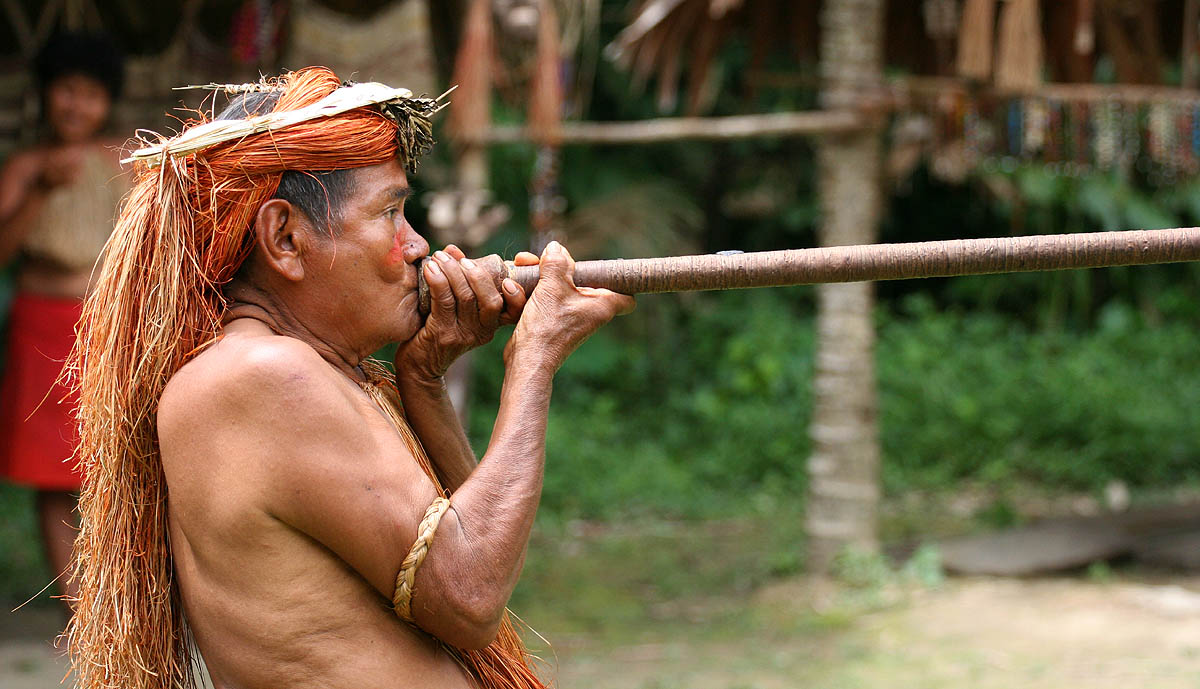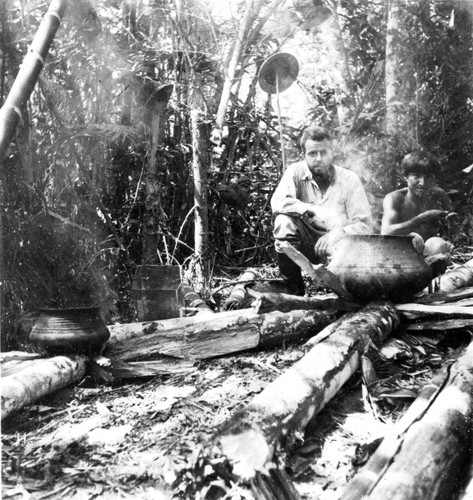Explorer and botanist: The story of Richard C. Gill and curare - a blog post from the Heritage Centre
Richard C. Gill could be described as an adventurer, certainly a researcher, and an amateur ethnographer and botanist. Gill was born in America in 1901. Following in the family tradition, at university he studied medicine, but only for two years before deciding it wasn’t for him. He went on to read English at Cornell University and subsequently worked as a teacher and a Ranger in Yellowstone National Park. In 1928 he moved to South America to work for a rubber company, but left when the business was hit by the Great Depression in 1929. Gill and his wife Ruth loved the country so much, they decided to stay and establish a ranch to grow coffee and plants, and from where Richard could study the culture of the local peoples, and explore the jungle. After eight months of searching, they bought land in Ecuador and built the Rio Negro ranch.
Whilst living on the ranch, Gill made many expeditions into the jungle where he studied the people and built relationships with the local tribes and their leaders. His studies included their social practices, music, and use of botanicals for medicine. He became fascinated by the herbal remedy preparations of the shamans and watched them prepare arrow poison (curare). The tribes used curare coated darts or arrows in blow pipes and bows to shoot and kill or stun animals for food and clothing. When injected into the bloodstream curare acted as a muscle relaxant, which paralysed and asphyxiated prey. The mixing of curare poison and creating weapons is a highly skilled process. Different strength of poison is needed depending on the size of the prey, and mixing these accurately can only be determined by taste, curare is not toxic through ingestion alone. Learning about this poison directly from those that prepared and used it was therefore very important.

Yahua Blowgun Amazon Iquitos Peru, Creative Commons Attritbue photographer JialiangGao
However, arrow poison was not a new discovery, it has been known to Europeans since Sir Water Raleigh’s expeditions to Guyana in 1595. It was first brought back to England in the 1760s by Edward Bancroft (1741-1821) who had encountered the poison during his time in Guyana writing, An Essay on the Natural History of Guiana in South America.
In the nineteenth century, Naturalist Charles Waterton (1782-1865) brought curare samples, or ‘wourali’ as he called it, back to England and conducted experiments on animals. In 1814 at the Royal Vetinanary College in London, along with Benjamin Collins Brodie, Waterton administered wourali to a donkey whilst ventilating it with bellows until the poison wore off.
After Waterton’s experiments, more scientific work was conducted by physicians of the nineteenth century. It was Claude Bernard’s (1813-78) experiments on frogs in 1844 which showed conclusively that curare was acting as a muscle relaxant. He noted that, “it is an anaesthetic agent only in appearance. The animal feels, but cannot show it”.
However, it wasn’t until Gill’s discoveries in the 1930s that the scientific research of curare really got underway.
Gill’s determination is shown by the physiotherapy care plan he devised for himself, which in two years saw him able to drive, and by 1938, he was able to walk with the aid of a walking stick.
In 1932, Gill fell from a horse and suffered neurological symptoms, the symptoms were assumed to be a result of the fall, but he was later diagnosed with multiple sclerosis. A severe attack in 1934 left Gill with near total paralysis and severe muscle spasms. This led him and his neurologist Walter Freeman to explore the idea of using curare to alleviate the spasms. Gill’s determination is shown by the physiotherapy care plan he devised for himself, which in two years saw him able to drive, and by 1938, he was able to walk with the aid of a walking stick. Throughout his rehabilitation he taught himself botany, spoke with pharmacists, botanists and doctors and read relevant texts, he was also making plans for an expedition to collect curare and plants which might relieve his symptoms.
In May 1938, funded by Sayre Merrill, Gill set off into the jungle in search of curare and other plant specimens with a crew of around 95 people, 36 mules, 12 canoes and two tons of equipment. The trip to the jungle base camp took three weeks. The camp was fully equipped with thatched roofed buildings housing living and sleeping quarters, a kitchen, office and laboratory. Here Gill hoped, “to see curare being made, learning all I could about its making, and bringing back that knowledge for those who needed it.” After five months he had done just that. Gill and his crew returned with around 75 plants and 12kg of curare.
Gill sent his plant specimens and botanical specimens of curare, which he’d collected, dried, and pressed, to botanist B.A. Krukoff at the New York Botanical Garden to be identified. They became part of the Steere Herbarium’s collection, where they remain today.

Gill manufacturing curare, c.1938 Arthur Guedel Anaesthesia Collection, University of California San Francisco
On returning to America, Gill supplied some of the curare to A.E. Bennett, a psychiatrist from Nebraska and A.R. McIntyre, Chairman of the Department of Pharmacology of the University Of Nebraska College Of Medicine. McIntyre agreed to standardise it and Bennett used it in early trials with patients suffering compilations from shock therapy treatment. In 1939, E.R. Squibb and Son bought Gill’s supply of curare and began researching its properties. Two of Squibb’s scientists reported that they had been able to extract an alkaloid similar to d-tubocurarine from the bark of Chondrodendron Tomentosum and had developed a new method for preparing curare. It was also found to be in the bark of Strychnos Toxifera. This synthesised curare was marketed by E.R. Squibb and Son in 1939 as Intocostrin. It was first used in electroconvulsive therapy (ECT) to control spasms during convulsion therapy, in the treatment of tetanus, and finally in 1942 for anaesthesia.
Before the advent of curare in the 1940s, in order to achieve muscle relaxation anaesthetists would have had to administer a very deep ether or cyclopropane anaesthesia, which could cause a number of heart, liver or kidney complications.
The synthesised curare was successfully used in anaesthesia when Harold Griffith and Enid Johnson used the preparation of curare, Intocostrin, successfully in 25 patients who were lightly anaesthetised with cyclopropane. In Britain, Cecil Gray found Intocostrin unreliable and instead popularised the use of d-tubocurarine chloride, which was more consistent in its potency. D-tubocurarine would become the muscle relaxant of choice until curare-like synthetic agents replaced natural curare from the 1980s onwards.
Before the advent of curare in the 1940s, in order to achieve muscle relaxation anaesthetists would have had to administer a very deep ether or cyclopropane anaesthesia, which could cause a number of heart, liver or kidney complications. Additionally, with the total paralysis of a patient’s diaphragm, these surgeries were only possible with the invention of tracheal intubation and mechanical ventilation of the lungs.
Now, with muscle relaxants and manual ventilation, life saving heart, brain and thoracic surgeries can be performed.
You may also be interested in: